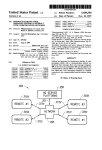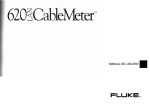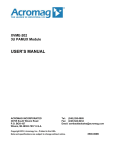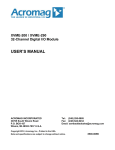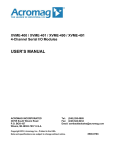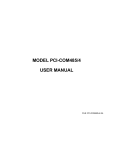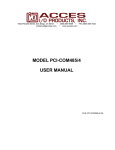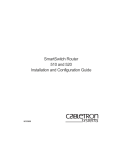Download D-Link DE-220P User's Manual
Transcript
DE-220P Installation Guide Ethernet Card Model DE-220P series (DE-220PCAT, DE-220PCT DE-220PT) Installation Guide Rev.05(Jan. 1997) 6DE-220-P..-.05 Printed in China WARRANTIES EXCLUSIVE IF THE D-LINK PRODUCT DOES NOT OPERATE AS WARRANTED ABOVE THE CUSTOMER’S SOLE REMEDY SHALL BE, AT D-LINK’S OPTION, REPAIR OR REPLACEMENT. THE FOREGOING WARRANTIES AND REMEDIES ARE EXCLUSIVE AND ARE IN LIEU OF ALL OTHER WARRANTIES, EXPRESSED OR IMPLIED, EITHER IN FACT OR BY OPERATION OF LAW, STATUTORY OR OTHERWISE, INCLUDING WARRANTIES OF MERCHANTABILITY AND FITNESS FOR A PARTICULAR PURPOSE. D-LINK NEITHER ASSUMES NOR AUTHORIZBS ANY OTHER PERSON TO ASSUME FOR IT ANY OTHER LIABILITY IN CONNECTION w i t h INSTALLATION MAINTENANCE OR USE OF D-LINK’S D-LINK SHALL NOT BE LIABLE UNDER THIS WARRANTY IF ITS TESTING AND EXAMINATION DISCLOSE THAT THE ALLEGED DEFECT IN THE PRODUCT DOES NOT EXIST OR WAS CAUSED BY THE CUSTOMER’S OR ANY THIRD PERSON’S MISUSE, NEGLECT, IMPROPER INSTALLATION OR TESTING, UNAUTHORIZED ATTEMPTS TO REPAIR, OR ANY OTHER CAUSE BEYOND THE RANGE OF THE INTENDED USE, OR BY ACCIDENT, FIRE. LIGHTNING OR OTHER HAZARD. LIMITATION OF LlABlLlTY IN NO EVENT WILL D-LINK BE LIABLE FOR ANY DAMAGES, INCLUDING LOSS OF DATA, LOSS OF PROFITS, COST OF COVER OR OTHER INCIDENTAL, CONSEQUENTIAL OR INDIRECT DAMAGES ARISING OUT THE INSTALLATION, MAINTENANCE. USE, PERFORMANCE, FAILURE OR INTERRUPTION OF A D- LINK PRODUCT, HOWEVER CAUSED AND ON ANY THEORY OF LIABILITY. THIS LIMITATION WILL APPLY EVEN IF D-LINK HAS BEEN ADVISED OF THE POSSIBILITY OF SUCH DAMAGE. IF YOU PURCHASED A D-LINK PRODUCT IN THE UNITED STATES, SOME STATES DO NOT ALLOW THE LIMITATION OR EXCLUSION OF LIABILITY FOR INCIDENTAL OR CONSEQUENTIAL DAMAGES, SO THE ABOVE LIMITATION MAY NOT APPLY TO YOU. Limited Warranty D-Link warrants its hardware products to be free from defects in workmanship and materials, under normal use and service, for the following lengths of time from the date of purchase from D-Link or its Authorized Reseller: Product Type Network adapters Unmanaged and managed hubs Repeaters, MAUs , transceivers, media converters Concentrators lntemetworking products * Power supply and fans in these devices Other hardware products Spare parts and spare kits Lifetime Lifetime * One year One year One year One year One year 90 days If a product does not operate as warranted during the applicable warranty period , D-Lmk shall, at its option and expense, (1) repair the defective product as part, (2) deliver to Customer an equivalent product or part to replace the defective item.All products that are replaced will become the property of D-Link. Replacement products may be new or reconditioned. Any replaced or repaired product or part has a ninety (90) day warranty or the remainder of the initial warranty period, whichever is longer. D-Link shall not be responsible for any software, fiiware, information, or memory data of Customer contained in, stored on, or integrated with any products returned to D-Link pursuant to any warranty. All products with lifetime warranty have a standard five-year warranty. To qualify for lifetime warranty, the enclosed Product Registration Card must be completed and returned to D-Link within ninety (90) days of purchase. Warranty service may be obtained by contacting a D-Link office within the applicable warranty period for a Return Material Authorization (RMA) number. If a Registration Card has not been previously sent, proof of purchase, such as a copy of the dated purchase invoice, must be provided Once an RMA number is issued, the defective product must be shipped back to D-Link prepaid, insured and wrapped in the original or similar shipping package to ensure that it will not be damaged during shipment. When returning the defective product to D-Link for service, the RMA number must be marked on the outside of the shipping package. Any product returned without an RMA number shah be rejected and sent back to the Customer, and D-Link reserves the right to have Customer bear the cost of sending back such products. A service charge may or may not be levied to Customer by D-Link. To find out if a service charge IS levied or not, and the charged amount, read the RMA that is returned to Customer, or ask the D-Link office when an RMA is requested. D-Link Offices to Contact for Warranty Service: To mail your Registration Card, or to obtain an RMA number or a warranty service, see the following addresses: U.S.A. CANADA U.K. FRANCE SWEDEN DENMARK SINGAPORE AUSTRALIA CHINA JAPAN INDIA TAIWAN Trademarks Copyright C D-Link Corporation. Contents subject to revision without prior notice. D-Link and LANsmart Corporation. are registered trademarks of D-Link All other trademarks belong to their respective owners. Copyright Statement No part of this publication may be reproduced in any any means or used to make any derivative (such as transformation or adaptation) without permission from Corporation/D-Link Systems Inc., as stipulated by States Copyright Act of 1 976. FCC n from or by translation, the D-Link the United CERTIFICATIONS FCCID: DE-220PCAT : KA2APC26OPl DE-220PCT/PT : KA2APC26OPO The device complies with Part 15 of the FCC Rules. Operation is subject to the following two conditions: (1) this device may not cause harmful interference, and (2) this device must accept any interference received, including interference that may cause undesired operation. The equipment has been tested and found to comply with the limits for a Class B digital device, pursuant to Port 15 of the FCC Rules. These limits are designed to provide reasonable protection against harmful interference when the equipment is operated in a commercial environment. This equipment generates, uses, and can radiate radio frequency energy and, if not installed and used in accordance with the Instruction manual, may cause interference in which case user will be required to correct the interference at his own expense. This product generates and used energy of about the same frequency as radio and TV broadcasts. Installed incorrectly, it it may interfere with reception of radio and TV broadcasts. If you suspect this product is causing interference, turn your computer on and off while the radio or TV is showing interference. If the interference disappears when you;u turn the computer off and reappears when you turn the computer on, something in the computer is causing interference. To reduce interference, try these suggestions: - Change the direction of the radio of TV antenna. - Move the computer, radio or TV. For example, if the computer is to the right of the TV, move it to the left of the TV. Or move them farther apart. - Plug the computer into a different electrical outlet than the radio or TV. ensure that all expansions slots (on the back or side of the computer) are covered. Also ensure all metal retaining brackets are tightly attached to the computer. TABLE OF CONTENTS INTRODUCTION .............................................. l-l Features ........................................................... l-2 Overview of PnP ............................................... l-5 INSTALLATION ................................................ 2-7 Single-Adapter Installation Multiple-Adapter Installation ................................ .2-8 .............................. .2-9 Multiple Cards in a PnP System ........................ 2-10 Multiple Cards in a Non-PnP System ................ .2-10 Network Cable Connections .............................. 2-11 The Network Medium is Twisted-Pair Cable ...... 2-13 The Network Medium is Thin Coaxial Cable ..... ..2-14 The Network Medium is Thick Coaxial Cable .... .2-15 SPECIFICATIONS ............................................ 2-16 Introduction The D-Link DE-220P Series is a new line of Plug and Play Ethernet, adapters based on the technology of DLinks best,-selling DE-220 Ethernet adapters. Plug and Play (PnP) technology provides automatic configuration of newly installed devices without, user intervention, eliminating much guess-work from installation of PC upgrades. Ease of use is the hallmark of the DE-220P Series. After installing a DE-220P Series card, configuration is exceedingly simple for both traditional (non-PnP) systems and the newer PnP-compliant, systems. For PnP systems, simply install the DE-220P Series card into an expansion slot. Configuration by the system software then proceeds automatically. If multiple network interface cards are installed, the PnP system guarantees that, there are no conflicts among them. For non-PnP systems, just, install the DE-220P Series adapter into an available expansion slot, then run the supplied setup program, setup. exe. Online help answers your questions, and an advanced diagostic DE-22OP Series Ethernet Adapter / User’s Guide ---_-_________-___-_-------------- program is supplied for testing adapter functions and communication with other computers on the network. Features DE-220P Series Ethernet, adapters comply with IEEE 802.3 Ethernet standards, and use VLSI components for enhanced reliability. The following features distinguish D-Link DE-220P Series Ethernet, adapters: + Easy Installation DE-220P Series Ethernet, adapters have no physical jumpers or DIP switches. Thus it, is never necessary to remove a DE-220P Series card in order to reconfigure. When installed in a PnPsystem , configuration is handled compliant e n t i r e l y b y system software, w i t h n o u s e r configuration intervention. In non-PnP systems, is accomplished by running the supplied setup program. + Support, for 8-bit, and 16-bit. Expansion Slots DE-220P Series Ethernet, cards can be installed in 8-bit, (XT-style) or 16-bit (AT-style) expansion slots. The adapter will automatically detect the type of its expansion slot. l-2 introduction DF220P Series Ethernet Adapter / User’s Guide _--~~--~~~----------~~-----~~----~ NE-2000 Drivers DE-220P Series Ethernet adapters are fully compatible with network drivers for Novell NE2000 adapters. Diagnostic Program A supplied diagnostic program tests all functions of the DE-220P Series adapter and verifies its communication with another computer on your network. LEDs Two LEDs provide network state information: 1. PWR/Tx Indicator Steady green (Power indicator) shows that the adapter has power (computer power is ON and power is supplied to the adapter). Flashing green (Transmission indicator) shows that the computer is transmitting onto the network. This function applies only when the network medium is twisted-pair cable.’ ’ See Footnote 5, Page 2-12. Introduction l-3 DE-22OP Series Ethernet Adapter / User’s Guide ____-----____----___-~~----------~ 2. LNK/Rx indicator Steady green (Linkage indicator) shows that there is a good data linkage to the network. Flashing green (Reception indicator) shows that, the computer is receiving from the network. This function applies only when the network medium is twistsed-pair cable.’ + Remote boot option A Remote Boot, ROM is available per optional order. The Remote Boot ROM easily snaps into a mount on the DE-220P Series card to provide for remote booting of computers which do not, store a boot. program. + Runs a wide variety of networking software DE-220P Series Ethernet adapters can be used with these networking systems: l-4 D-Link LANsmart, D-Link TCP/IP for DOS NDIS driver Novell NetWare 3.x and 4.x ODI driver MS LAN Manager Windows for Workgroups Introduction DE-22OP Series Ethernet Adapter / User’s Guide _-______________------------------ Windows 95 Windows NT & Windows NT Advanced Server SUN PC-NFS DEC Pathworks Banyan VINES IBM LAN Server & PC LAN Support Program Packet, Driver 3Com 3+0pen 3+Share FTP PC/TCP WIN/TCP Pathway Access for DOS SC0 UNIX AT&T UNIX UNIXware Solaris UNIX & 3Com Overview of PnP Plug and Play technology (PnP) is defined by Plug and Play ISA Specification v. l.Oa. A fully functional PnP system includes a PnP-compliant, operating system, a PnP system BIOS, and PnP-compliant, interface cards. Windows 95 is the first popular PnP-compliant operating system. Computer mainboards with PnP BIOS’s are just reaching the market. In the interim, PnP technology still provides substantial benefits. For example, after installing a non-PnPcompliant, Ethernet, adapter card (a traditional, nonPnP-compliant, card may be called a legacy card) into Introduction l-b -DE-220P - - - - Series - - - Ethernet - - - - -Adapter - - - - /- User’s - - - Guide - - - - - - - - - - - - - an expansion slot, of’ a PnP-compliant mainboard, the user can run the ISA Configuration Utility (ICU) to configure the adapter. For some legacy cards, the user will need to set, DIP switches or jumpers on the card to configure it. to the system resources reported available by the ICU. With other legacy cards like the D-Link DE-220 and DE220E, configuration is accomplished by running the supplied setup program. l-6 Introduction DE-220P Series Ethernef Adopter / User’s Guide ---------_--_--------------------- Ins talla tion CAUTION: Under ordinary circumstances, a DE-220P Series card will not be affected by static charge as may be received through your body during handling of the unit. In special circumstances where you may carry an extraordinarily high static charge, it is good practice to reduce the charge by touching a ground before handling the adapter. Installation of a DE-220P Series Ethernet, adapter requires these three steps: + Install the adapter into an available expansion slot,. + Connect, network cable to the adapter. + For non-PnP systems, configure the adapter by running the supplied setup program, setup. exe. (For PnP-compliant, systems, this step is fully automated and requires no action.) This chapter provides detailed procedures for these three steps. When these steps are completed, you may Installation 2-7 DE-220P Series Ethernet Adapter / User’s Guide ---------------------------~~~~~~~ run the diagnostic routines of setup. exe program to test the configuration. Single-Adapter Installation 1. Shut down the computer, unplug its power cord, and remove the chassis cover. 2. Insert the DE-220P Series card into the connector of any open ISA expansion slot. You may choose either an 8-bit or l6-bit, expansion slot,. A l6-bit, slot, will provide better network performance. Ascertain that, the card is fully seated in the expansion slot connector. 3. Install the bracket, screw which secures the card to the computer chassis. 4. Replace the cornputer’s chassis cover. 5. For non-PnP systems, configure the DE-220P Series adapter by running the supplied setup program, setup. exe. (For PnP-compliant systems, this step is fully automated and requires no action.) 2-8 Installation - - - - - - - - - - - DE-22OP - - - - Series - - - -Ethernet - - - -Adapter - - - - /- User’s - - - -Guide - - Multiple-Adapter Installation Multiple DE-220P Series cards may be installed in a computer to provide for multiple addresses, or in the case of a server, to provide for network segmentation. Multiple Cards in a PnP System No special attention is needed when installing multiple DE-220P Series cards in a PnP-compliant system (so long as Plug and Play is enabled). Install the several cards into their expansion slots, following the four steps set, out in the “SingleAdapter Installation” section above (repeating steps 2 and 3 for each card). When computer power is switched on, the PnP system will automatically coordinated (conflict,-free) select configuration settings for the several cards. 3 Pl ug and Play functionality of the NOS may be toggled between enable and disable by a selection in your setup.exe run. Installation 2-9 -DE-220P - - - - Series - - - Ethernet - - - - -Adapter - - - - /- User’s - - - Guide - - - - - - - - - - - - - Multiple Cards in a Non-PnP System In non-PnP systems, the procedure for configuring multiple DE-220P Series cards is basically a sequence of separate single-adapter procedures: make a preliminary installation of each card alone in turn: make a setup. exe run to configure that card, then remove that card and go on to the next,. CAUTION: The following procedure involves operation of the computer without its chassis housing in place. Caution is necessary in order to avoid contact Accidental with exposed high-voltage parts. contact with exposed internal parts can cause personal injury and can cause damage to the computer equipment. Make a preliminary installation of the first, DE220P Series card by completing Steps 1 through 3 as set out. in the ‘Single-Adapter Installation” section above. Restore power to the computer, and configure the card by running the supplied setup program, setup. exe. Make a note of the configuration settings that, you select, to help you select, different settings in configuring the remaining cards. Shut. down the computer and unplug its power cord. Remove the (configured) card, and install the next. D E - 2 2 0 P pansion 2-10 slot. Series i dn t o anyopen ex- DE-220P Series Ethernef Adapter / User’s Guide __---_-______-__-__-______________ 4. Restore power to the computer. and configure the card by running the supplied setup program, setup. exe. Be certain that you select, different configuration settings from those that, have been selected for another card. Make a note of the configuration settings you select, to help you select different settings in configuring remaining cards. 5 Repeat Steps 3 and 4 as necessary to configure all DE-220P Series cards which are to be included in the multiple-card installation. 6. Shut down the computer and unplug its powercord. Re-install all of the configured cards. Replace the computer’s chassis cover. Network Cable Connections Before connecting a network cable to the DE-220P Series adapter, ascertain that your DE-220P model suits your network cable medium, as summarized in the following table.4 Then refer to one of the three 4 Models DE-220PCT and DE-22OPCAT feature multiple network cable connectors for convenience during network cable upgrades, and for versatility when your equipment is moved between areas with different types of network media. Only one network cable may be connected to any adapter in any given installation. Installation 2-11 DE-220P Series Ethernet Adapter / User’s Guide -------_------_-----------~------~ sections following, according to your network cable type. Model Network Cable Types DE-220PT Twisted-Pair5 DE-220PCT Thin Coaxial’ and Twisted-Pair DE-220PCAT Thick Coaxial’. Thin Coaxial, and Twisted-Pair 5 6 only Twisted-pair (TP) cable features RJ-45 connectors, and is available with or without EM shield. TP cable without EM shield is. also known as 1OBaseT cable or UTP (Unshielded Twisted-Pair) cable. TP cable with EM shield is known as screened twisted-pair cable, and the EM shield may be either an aluminum sheath or a copper braid enclosing the twisted-pair bundle. This medium features BNC connectors and is known by a variety of other names. including lOBase2 cable, BNC cable, and RG-58 rable. This medium features AUI connectors and is also known as lOBase5 cable. It is sometimes called by names such as “frozen yellow garden hose,” due to its bulk, weight, and stiffness. 2-12 Installation - - - - - - - - - - -DE-220P - - - - Series - - - Ethernet - - - - -Adapter - - - - /- User’s - - - Guide - - - The Network Medium is TwistedPair Cab/e 1. Ascertain that, you have a straight,* twistedpair cable not, more than 100 meters (328 feet) in length for the network connection. 8 Pins 1 and 2 must be a pair (the connected wires must be a twisted pair in the cable makeup) and pins 3 and 6 must he a pair. Each pin must connect, straight through the rahle (that is pin 1 through to pin 1 of the opposite connector. pin 2 to pin 2. pin 3 to pin 3, and pin 6 to pin 6: pins 4.5. 7.8 are not, used). Installation 2-13 DE-220P Series Ethernet Adapter / User’s Guide ---------_-------__--------------- 2. The cable will have an RJ-45 plug on each end. Plug one end into the RJ-45 receptacle of the DE-220P Series adapter, and plug the other end into an available port, of a lOBase-T hub. Push each RJ-45 plug into its receptacle until its retainer snaps into place. The Network Medium is Thin Coaxial Cable 1. Connect, a BNC T-connector onto the BNC receptacle of the DE-220P Series card. 2. Connect, the network feed cable onto either open end of the BNC T-connector. 3a. If the cable continues on to an additional station or stations, then connect. the continuation cable onto the remaining open end of the BNC Tconnector. 3b. If the network cable does not, continue to additional stations (your computer is at, the end of the cable), then connect, a 50-ohm terminator to the remaining open end of the BNC T-conector. 2-14 /nsta//ation DE-220P Series Ethernet Adopter / User’s Guide _______--------------------------- BNC T-ccnnector The Network Medium is Thick Coaxial Cab/e 1. If there is no Ethernet transciever (tap) in place for your computer’s station on the network cable, then install a transciever (not, supplied). 2 Connect. one end of an AUI cable to the Ethernet, transceiver. 3. Connect. the other end of the AUI cable to the AUI connector of the DE-220PCAT. Thick coaxial cable Installation 2-15 DE-220P Series Ethernet Adapter / User’s Guide - - - - - - - - - - - - - - - - - - - - - - - - - - - - - - - - - - Specifications Model: AUI connector for thick coaxial BNC connector for thin coaxial RJ45 connector for twisted-pair CE / FCC Class B Maximum power consumption Size (cm) IRQ options I/O Base Address options Boot ROM Size Boot Base Address options LED Indicators Operating Temp. Storage Temp. Humidity 2-16 DE-220PCAT YES DE-220PCT NO DE-220PT NO YES YES NO YES YES YES YES YES 3.5 Watts YES 1 Watt 3.5 Watts 240H, 260H, 280H, 2AOH, 2COH, 2EOH, 3OOH, 320H, 340H, 360H, 380H 16K (supplied per optional order) C800H, CCOOH, WOO, D400H, D800H, DCOOH Power/TX (Green), Rx/Link (Green) 32°F to 131°F (0°C to 55°C) -4F to 176°F (-20°C to 8OC) 10% to 90% non-condensing Specifications

























